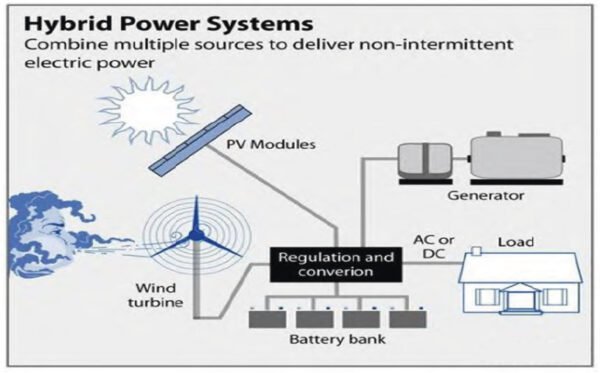Hind Hybrid Electrification
The Hybrid Electrification consists of following component
a) Wind Turbine
b) Solar Module
c) Power Conditioning Unit (PCU)
d) Battery Bank
Hybrid Electrification Line Diagram

Advantages of Wind Hybrid Electrification :-
The Hybrid Electrification consists of following component
a) Complementary resource characteristics: Wind and Solar energy resources are complementary on a diurnal basis, with peak wind times after sunset and before sunrise and peak solar times aligning with periods of the lower wind resources.
b) Efficient use of land: To make efficient use of land between wind turbines & solar which are duly spaced apart to avoid row effects.
c) Analogous technical processes: Both Wind and Solar rely on natural sources and can be integrated into common AC or DC output to feed into the local utility grid.
d) Cost efficiency from shared infrastructure: Shared data collection systems, O&M service facilities, asset management and common point of interconnection are beneficial for cost efficiency, especially for projects with higher capacities.
Additional Benefits Of Wind Hybrid Electrification:-
Hybrid Renewable System – Combining wind and solar energy resources in a fully integrated platform.
- High Energy Density – Wind and Solar energy generation within a compact footprint, creates the greatest energy density (Energy/sq. Meter) of any product on the market.
- Scalable – The units can be interconnected to increase a user’s energy production capability.
- Unique – The hybrid power plant seamlessly integrates wind and solar energy generation in a single unit. This allows the product to be an effective solution in markets where the natural resources available for wind and solar energy generation.
Implementation Strategy:-
The implementation of a Wind Hybrid Electrification System will depend on different configurations and use of technology.
Wind Hybrid Electrification – DC integration:
DC integration is possible in case of variable speed drive wind turbines using converter-inverter. In this configuration, the DC output of both the Wind and Solar PV plant is connected to a common DC bus and a common inverter suitable for combined output AC capacity is used to convert this DC power into AC power. The DC-coupling topology has the advantages of simplified hardware, lower cost and higher energy efficiency.
1 kw Wind Hybrid Electrification
Specification :
1) 1kw Wind Turbine
2) 1.5kw Solar Power System
3) 4* 12v/150Ah Battery
4) 2 KVA PCU
3.5 kw Wind Hybrid Electrification
Specification :
1) 3.5kw Wind Turbine
2) 3.2kw Solar Power System
3) 12* 12v/200Ah Battery
4) 5 KVA PCU
5 kw Wind Hybrid Electrification
Specification :
1) 5kw Wind Turbine
2) 5kw Solar Power System
3) 20* 12v/200ah Battery
4) 7.5 KVA PCU
10 kw Wind Hybrid Electrification
Specification :
1) 2* 5kw Wind Turbine
2) 10kw Solar Power System
3) 40* 12v/200ah Battery
4) 15 KVA PCU
